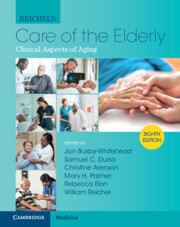Book contents
- Reichel’s Care of the Elderly
- Reichel’s Care of the Elderly
- Copyright page
- In Memoriam
- Contents
- Contributors
- Section I General Approach to the Care of the Elderly
- Section II Geriatric Syndromes
- Section III Care of the Elderly by Organ System
- Chapter 13 Diagnosis and Management of Heart Disease
- Chapter 14 Hypertension
- Chapter 15 Peripheral Artery Disease
- Chapter 16 Neurologic Problems
- Chapter 17 Prevention, Diagnosis, and Management of Stroke
- Chapter 18 Movement Disorders
- Chapter 19 Sleep Disorders
- Chapter 20 Clinical Geropsychiatry
- Chapter 21 Substance Use Disorder
- Chapter 22 Pulmonary Issues
- Chapter 23 Gastrointestinal Disorders
- Chapter 24 Serious Infections
- Chapter 25 Human Immunodeficiency Virus
- Chapter 26 Kidney Disease
- Chapter 27 Urological Conditions
- Chapter 28 Urinary Incontinence
- Chapter 29 Fecal Incontinence
- Chapter 30 Gynecologic Issues
- Chapter 31 Endocrine Disorders
- Chapter 32 Diabetes Mellitus
- Chapter 33 Lipid Management
- Chapter 34 Osteoporosis and Other Metabolic Bone Disorders
- Chapter 35 Common Rheumatologic Disease
- Chapter 36 Geriatric Emergency Medicine
- Chapter 37 Musculoskeletal Injuries
- Chapter 38 Dermatologic Conditions
- Chapter 39 Pressure Injuries
- Chapter 40 Anemia and Other Hematological Problems
- Chapter 41 Cancer
- Chapter 42 Ocular Disorders
- Chapter 43 Geriatric Otolaryngology
- Chapter 44 Oral Health
- Chapter 45 Foot Health
- Section IV Principles of Care for the Elderly
- Index
- Plate Section (PDF Only)
- References
Chapter 17 - Prevention, Diagnosis, and Management of Stroke
from Section III - Care of the Elderly by Organ System
Published online by Cambridge University Press: 30 June 2022
- Reichel’s Care of the Elderly
- Reichel’s Care of the Elderly
- Copyright page
- In Memoriam
- Contents
- Contributors
- Section I General Approach to the Care of the Elderly
- Section II Geriatric Syndromes
- Section III Care of the Elderly by Organ System
- Chapter 13 Diagnosis and Management of Heart Disease
- Chapter 14 Hypertension
- Chapter 15 Peripheral Artery Disease
- Chapter 16 Neurologic Problems
- Chapter 17 Prevention, Diagnosis, and Management of Stroke
- Chapter 18 Movement Disorders
- Chapter 19 Sleep Disorders
- Chapter 20 Clinical Geropsychiatry
- Chapter 21 Substance Use Disorder
- Chapter 22 Pulmonary Issues
- Chapter 23 Gastrointestinal Disorders
- Chapter 24 Serious Infections
- Chapter 25 Human Immunodeficiency Virus
- Chapter 26 Kidney Disease
- Chapter 27 Urological Conditions
- Chapter 28 Urinary Incontinence
- Chapter 29 Fecal Incontinence
- Chapter 30 Gynecologic Issues
- Chapter 31 Endocrine Disorders
- Chapter 32 Diabetes Mellitus
- Chapter 33 Lipid Management
- Chapter 34 Osteoporosis and Other Metabolic Bone Disorders
- Chapter 35 Common Rheumatologic Disease
- Chapter 36 Geriatric Emergency Medicine
- Chapter 37 Musculoskeletal Injuries
- Chapter 38 Dermatologic Conditions
- Chapter 39 Pressure Injuries
- Chapter 40 Anemia and Other Hematological Problems
- Chapter 41 Cancer
- Chapter 42 Ocular Disorders
- Chapter 43 Geriatric Otolaryngology
- Chapter 44 Oral Health
- Chapter 45 Foot Health
- Section IV Principles of Care for the Elderly
- Index
- Plate Section (PDF Only)
- References
Summary
Stroke is an episode of sudden neurological dysfunction caused by focal ischemia of the central nervous system leading to cell death. Transient ischemic attack (TIA) is a transient episode of neurological dysfunction, without acute infarction. Stroke is a leading cause of long-term disability and the fifth leading cause of death in the United States. Advancing age remains a leading nonmodifiable risk factor for stroke. Targeting modifiable risk factors is critical to preventing recurrent strokes. This includes screening for diabetes, initiating statin therapy, and identifying and treating atrial fibrillation and hypertension. Aspirin remains the preferred antiplatelet drug for secondary prevention of ischemic stroke (in the absence of an indication for anticoagulation); however, patients with minor stroke or TIA should be treated for at least 21–30 days with both aspirin and clopidogrel. The management of acute ischemic stroke centers around thrombolytic treatment and mechanical thrombectomy, to maximize cerebral perfusion to the ischemic brain tissue. This must be balanced against the risks for hemorrhagic complications. Common poststroke complications include venous thromboembolic disease, dysphagia, and depression. All members of the health-care team and physicians should communicate openly and frequently with patients, their families, and/or their caregivers to ensure that their goals of care are met.
- Type
- Chapter
- Information
- Reichel's Care of the ElderlyClinical Aspects of Aging, pp. 208 - 217Publisher: Cambridge University PressPrint publication year: 2022



